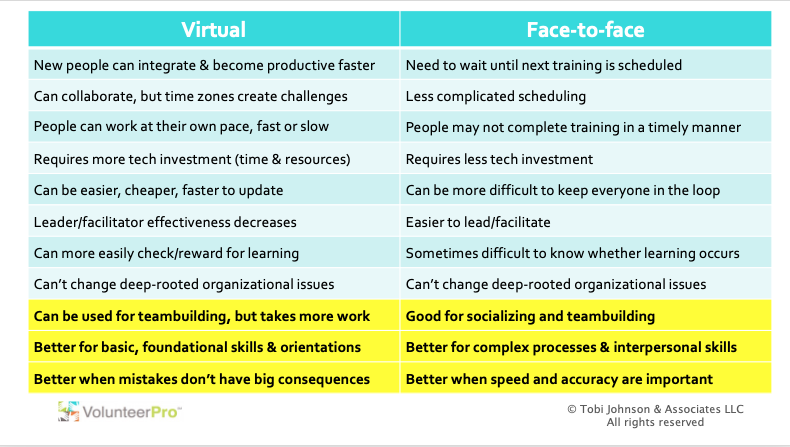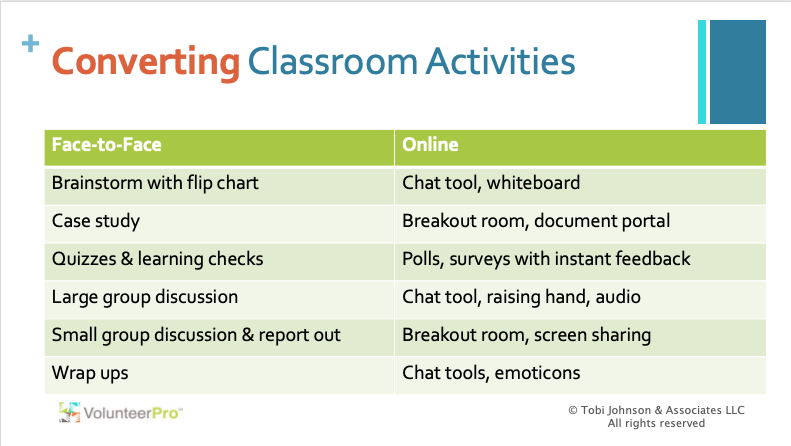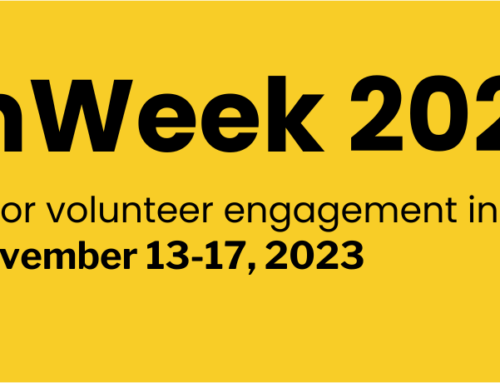 Training Volunteers Online: How Your Nonprofit Can Keep Your Supporters Up to Speed
Training Volunteers Online: How Your Nonprofit Can Keep Your Supporters Up to Speed
In the past, training volunteers took place mostly in person, through in-person workshops and intensive bootcamps. But, with COVID-19 disease transmission rates still on the rise, nonprofits are seeking new ways to engage and upskill volunteers that can also keep them safe.
Offering online volunteer training is the perfect solution and isn’t as complicated as you might think.
As a company that has developed virtual volunteer training curriculum for our consulting clients for over a decade, and has offered live webinars and online courses for over five years, we’ve had the opportunity to track the development of technology and evolve our practice at the same time.
The good news is that it is getting much, much easier to offer both live and on-demand skill building for volunteers.
First, webinar platforms have become easier to use. Nowadays, many do not require complicated downloads and app installations. Users simply click a link and enter the virtual training space via their browser.
In addition, online seminar platforms are now more stable than ever, offering presenters a relatively hassle-free experience with less danger of internet drop off or failure.
Finally, because the public has found themselves sheltering in place, more people are exploring ways to connect with their friends and families via video chat. Volunteers who may have been hesitant to try logging in to learn are now willing to give it a go. And, once they get over the hump, they can manage with relative ease.
Second, a plethora of affordable online course platforms have come onto the market that are easy to use. The standalone versions offer a logged in experience and individual learning libraries for each student.
The upside of these platforms, as opposed to delivering courses from your own website, is that the back-end technology is managed by the software provider. If tech issues arise, they take care of them, not you. This leaves you to focus on your own strengths, building and delivering great course content for your volunteers.
In addition, most course platforms offer analytics and the ability to drip or preschedule course content, based on pre-determined dates, module completions, or in-course quiz results. With all these automations, you can track and support student progress without a lot of administrative hassle.
What’s more, with the pandemic, online courses are becoming a more familiar way to learn for the public, beyond colleges and universities. The online course industry is booming, and it is only predicted to grow. Soon, it will become a way of life for most.
Today’s platforms are simple point and click affairs, and interfaces are easy to use, with less hassle and frustration. Plus, setting up online courses is easier than ever, with drag and drop functionality, most of your time is spent developing the content versus populating the platform.
When Training Volunteers Online Makes the Most Sense
While online volunteer training won’t solve every volunteer support issue, it can make learning easier, more convenient, and add greater flexibility for both your volunteers and you.
You can present live synchronous webinars and make replay recordings available to those who can’t join live, posted on your website, or set up a YouTube channel to host your volunteer orientations.
You can also develop asynchronous on-demand courses that volunteers can access at their leisure and complete when they have time. Volunteer trainings and orientations can also be posted on your website or hosted in an online course platform.
The benefit of creating a full online course, versus posting a series of videos online, is that you can follow completion rates, and each student has an individualized experience and can track their progress.
There are a variety of pros and cons to online versus in-person volunteer training. Below are a few.
But you don’t have to choose one over the other. Blended learning, which combines both online and face-to-face instruction with the content on one reinforcing the other, has been shown to be a highly effective strategy for successful knowledge transfer.
Pros and Cons: Virtual vs. Face-to-Face Volunteer Training
While it’s easy to think that online training will solve all your volunteer onboarding problems. It won’t.
If you have a poor system for welcoming volunteers, no amount of training will solve your volunteer retention issues.
For a few ideas on how to improve this part of the process, check out these two blog posts:
- 3 Strategies to Follow for a Better Volunteer Onboarding Journey
- How to Integrate Volunteer Onboarding for Better Engagement
Many of these recommendations can be converted for use in a virtual context.
How to Decide What Volunteer Content to Train Online
While online volunteer training won’t solve every volunteer support or onboarding challenge, it can go a long way in helping induct volunteers.
But if it isn’t designed well, it won’t have the intended impact.
I’ve written previously about the biggest mistakes people make when developing virtual volunteer training. Avoid these top fumbles, and you’ll be off to a better start.
You will also want to decide what volunteer content is best conveyed online.
Converting student interactions that normally take place in person can often be transformed to an online context easily, with some smart use of technology features. Many come with the software and are rarely used to engage. Below are a few ideas.
Ways to Convert from In-Person Activities to Online Engagement
But what about the actual course content? What is most proper for online instruction and what is better saved for in person work, when possible?
Volunteer training is all about building skills, competencies, and confidence to perform the tasks required for a specific role.
But volunteerism is also about social connections, a key driver of volunteer satisfaction. When volunteers feel connected to others, they are more likely to stay.
So, volunteer training is most effective when it includes a teambuilding element.
There are four levels of competency we need to develop in volunteer training programs. Below are those four levels, along with specific learning competencies.
In addition, competency can only be gained when practice approximates what is to be learned. So, practices activities must be developed that help the learner try out the skill and reflect on how it went. It is this reflection that creates learning that sticks.
Four Levels of Learning
- Level 1: Acquire Knowledge
-
- Competency: Declarative Knowledge
- Activity: Explain, draw, write
- Level 2: Build Procedural Skills
-
- Competency: Automatic Skills
- Activity: Fill out form, use database
- Level 3: Develop Strategic Skills
-
- Competency: Problem Solving
- Activity: Direct service scenarios
- Level 4: Form Relationships & Trust
-
- Competency: Teamwork
- Activity: Teambuilding games, project-based work
When it comes to online learning, the limitation is the technology and the ability for volunteers to practice a skill and develop relationships.
For this reason, Level 1: Acquire Knowledge and Level 2: Build Procedural Skills are the most appropriate to be taught online.
The other two levels can also be taught online live, with a smart use of virtual breakout rooms and discussions, but they can also be saved and taught during valuable face time if the time is right and it’s safe to do so.
If the possibility of face-to-face training is not currently practical, all levels can be trained online. They key will be the level and depth of engagement that is designed into the coursework. If it is robust, there is a better chance of authentic learning to occur.
Tech Options for Online Volunteer Training
While live webinars and online courses are the most used to train virtually, there are a myriad of use cases and options available for content sharing, reflection, and interaction between volunteers.
Below is a list of only a few tools. Consider how these, or others, might be combined to create a quality overall learning experience for volunteers.
Technology Tools
- Content Portals
- YouTube Channel
- File Sharing Platform (DropBox, Google Drive, OneDrive, etc.)
- Group Collaboration Tools (Padlet, Pearltrees, Gingko, Google Docs)
- Your Website, Volunteer Management System, or Learning Management System
- Webcasting
- YouTube Live, Facebook Live
- Webinar Platforms (Zoom, Freeconferencecall.com)
- Video Conferencing Platforms (Skype, Google Hangouts)
- Social Sharing
- Social Media (Private LinkedIn Group, Private Facebook Group)
- Group Communications (Slack, Socrative, Telegram)
-
- Listserv (Yahoo Groups)
-
- Your Volunteer Management System
- Your Volunteer Management System
- Quizzes & Feedback Surveys
- Quiz Creation Software (Typeform, ClassMarker, Online Quiz Creator)
- Survey Software (Google Forms, SurveyMonkey, Lime Survey)
When selecting software tools, the one thing to keep in mind is that the more bells and whistles a software has, the more expensive. Fully integrated learning management systems often come at a premium price.
However as new software solutions come online, and the marketplace becomes more competitive, we can expect to see more completely integrated solutions that nonprofits can afford.
Online learning is here to stay. Even without a pandemic to create urgency, nonprofits can use live and on-demand training sessions to orient and prepare volunteers for roles.
These tools can also be used to re-engage volunteers, upskill them, and prepare them for new and more intensive leadership roles.
Humans have a drive to learn and grow as people. Volunteerism is part of the self-actualization process and self-development (or gaining knowledge, skills, and abilities) and is a key part of what motivates volunteers to join and serve.
So, the more engaging, convenient, and fun your training is, the more likely volunteers will keep coming back for more.
Wonder if Your Current Volunteer Training Works? Try Our Free Evaluation Form
As you create or update you volunteer training, make sure you pilot test and evaluate whether it is effectively closing the skills gaps you intended.
Use our free, ready-to-use form to get candid feedback from volunteers about how to improve your orientation and training courses. Use it as a hard copy or set up a simple survey and link it to your online training course.








